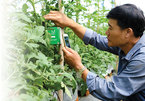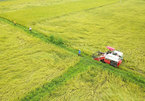 |
Digital technology can help Vietnam’s agriculture sector improve production efficiency, protect farms against traditional problems like pests and poor weather, and raise product quality, but this requires a workforce who are knowledgeable in agriculture and possess technical skills.
Digital requirements
Digitalization in agriculture is now an ongoing and unavoidable process and the final goal is to improve the reputation of products and quality of life for Vietnamese farmers.
The Loc Troi Group (LTG), one of largest agricultural producers and suppliers in Vietnam, recently introduced a high-tech agricultural project that uses drones to help farmers prevent disease and improve crop management through collecting crop data. The group also developed a digitized field diary data set to monitor and predict the advent of pestilence and disease to bolster field management and created an online gateway for farmers to ask questions and receive support via smartphone apps on managing pests and planting crops most effectively.
The group has also built a team of professional consultants and acquired highly-skilled technical staff with good expertise, an understanding of localities, and sound relationships with farmers and agents. It continues to focus on talent attraction and human resources training in key areas such as high-tech agricultural service projects, sales management, and diary data set digitalization, while optimizing supply chain resources and marketing and sales activities. “To meet the digitalization task in the group’s operations and production for 2020, recruitment and training will closely follow our production and business strategy in 2019,” Mr. Huynh Van Thon, Chairman and CEO of LTG, told VET.
Meanwhile, US agribusiness Cargill, which is investing in the food and agriculture sectors, has also boosted its operational system as well as talent development towards digitalization. The group is delivering technologies such as iQuatic™ to help shrimp farmers capture farming data and make actionable decisions in a timely manner, and transformed the Cargill Digital Supply Chain with digital technologies to better serve customers across the globe and in Vietnam. It has also developed an advanced, interactive, and customized digital learning portal where employees can pursue courses at home or at work.
The group has also developed a number of nutrition / bio-tech innovation centers and technical application centers in many countries, where it offers training opportunities to future talent with a strong digital focus. “In business, we are delivering digital tools on tablets to commercial teams so they can work on mobility and get connected anytime, anywhere to the data and processes they need to serve customers,” said Mr. Luan Nguyen Ba, Vietnam Country President of Cargill.
Adaptability skills
 |
LTG has training plans and budgets as well advantages in workplace environment and training courses. However, like many agricultural enterprises, the group has faced a lack of high-quality personnel as recruitment demand in the industry is huge. “We face tough competition in recruitment from other high-tech agricultural enterprises,” Mr. Thon said. “We will therefore partner with technology solution providers to transfer technology to our core team and pilot this in some key areas, before evaluating, adjusting, and then replicating the model.”
Operating on a small scale, Jan’s Co., a processed organic food provider, must tackle the same issues as LTG. Mr. Dang The Giang, the owner of Jan’s Co. and the 5-ha Fabulous Organic Farm in Da Lat, in the central highlands’ province of Lam Dong, told VET that demand for organic food is increasing so the company is continuing to develop and launch more new products for domestic consumption and export. “This requires more employees, but the labor market is small in the context of the digitalization being seen in Vietnam’s agriculture sector,” he said.
He explained that those who are trained at information technology (IT) universities lack knowledge in agriculture, while local farmers, who possess actual experience on the land, don’t have skills in IT. Employing analysts with knowledge of farming data and IT skills has proven to be problematic, and Jan’s and its subsidiaries spent ten years finding and retaining its 70 or so employees. “It’s not easy to find such a large number of high-quality employees,” Mr. Giang said. “We will utilize our current employees to implement new projects next year, which means that each employee will need to increase their productivity to adapt to the new challenges.”
To ensure it has high-quality employees amid limited supply, Cargill has been partnering with training and human resources partners to identify the best talent and stay updated on human resources trends over the last two decades. “We are also working with a dozen universities around Vietnam to find young and suitable talent that fit into our growth plan,” Mr. Luan said. “In the hiring process, the balance of power seems to be shifting away from employers and toward candidates, who can now apply for multiple positions with one click and find out details about potential employers, from salaries to career paths and company culture. The younger generations are learning fast and can quickly adapt to market changes, so it is important for companies to create room for talent to gain experience and grow.”
Linkage improvements
Vietnam is forecast to need 3.2 million workers with agricultural training and 4.5-6 million by 2020 and 2030, respectively, according to the Ministry of Agriculture and Rural Development (MARD). There are 38 universities, colleges, and training schools and many institutes under the ministry, but enrollments are declining. In addition to increasing the number of trainees, the quality of training also needs to be improved to meet new requirements.
To improve quality, according to the Vietnam National University of Agriculture, training should be based on the demand of enterprises and cooperatives and the development of the industry, especially for the training of rural workers.
A project on vocational training for rural workers in the 2011-2015 period covered nearly 1.1 million people, according to MARD, reaching 75 per cent of the plan. Nearly 870,000 people found jobs or improved their performance after such training. In the 2016-2019 period, the figure reached 82 per cent of the plan. Localities chose jobs that meet farmers’ requirements and focused on the main products of each locality, and training was attached to job promotions for rural workers.
A project on vocational training for rural workers in the agricultural sector in the 2021-2030 period is being compiled for submission to Prime Minister Nguyen Xuan Phuc for approval. Priority will be given to training programs in high-tech agriculture and startups for young workers, and each locality should have one or two training schools that meet local needs.
Ms. Valentina Barcucci, Labor Economist at the International Labor Organization (ILO) Vietnam, told VET that the government has to take important steps to improve labor conditions and vocational issues. She also suggested that agricultural promotions go together with vocational training in the context of ongoing digitalization. Vietnam should also have vocational certificates that workers can use everywhere, and continue to raise the level of certification through a skills recognition system. The country therefore needs to develop national occupational skill standards for vocational training. VN Economic Times
Nghi Do

Time is ripe for Vietnam's agriculture digitalization
Agriculture enterprises have been quite active in applying innovative solutions to transform towards digitalization.

Land accumulation essential to apply innovation in agriculture
Across Vietnam, there are 76 million small and scattered farming land lots. Their spread out and small nature slow the application of technology, stop companies from investing in agriculture and hinder
 An ongoing issue in the digitalization of the agriculture sector is that IT workers know little about farming and farmers know little about IT." itemprop="description" />
An ongoing issue in the digitalization of the agriculture sector is that IT workers know little about farming and farmers know little about IT." itemprop="description" />